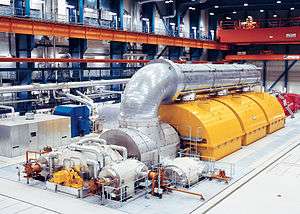Turbo generator





A turbo generator is the combination of a turbine directly connected to an electric generator for the generation of electric power. Large steam-powered turbo generators provide the majority of the world's electricity and are also used by steam-powered turbo-electric ships.[1]
Smaller turbo-generators with gas turbines are often used as auxiliary power units. For base loads diesel generators are usually preferred, since they offer better fuel efficiency, but, on the other hand, diesel generators have a lower power density and hence, require more space.
The efficiency of larger gas turbine plants can be enhanced by using a combined cycle, where the hot exhaust gases are used to generate steam which drives another turbo generator.
History
The first turbo-generators were water turbines which propelled electric generators. The first Hungarian water turbine was designed by the engineers of the Ganz Works in 1866; industrial-scale production with dynamo generators started in 1883.[2]
The turbo generator was invented by a Hungarian engineer Ottó Bláthy in 1903.[3] Unfortunately for Bláthy, Parsons had already demonstrated a DC steam-powered turbogenerator using a dynamo in 1887,[4] and by 1901 had supplied the first large industrial AC turbogenerator of megawatt power to a plant in Eberfeld, Germany.[5]
Turbo generators were also used on steam locomotives as a power source for coach lighting and heating systems.
Hydrogen-cooled turbo generator
Based on the air-cooled turbo generator, gaseous hydrogen first went into service as the coolant in a hydrogen-cooled turbo generator in October 1937, at the Dayton Power & Light Co. in Dayton, Ohio.[6] Hydrogen is used as the coolant in the rotor and sometimes the stator, allowing an increase in specific utilization and a 99.0% efficiency. Because of the high thermal conductivity, high specific heat and low density of hydrogen gas, this is the most common type in its field today. The hydrogen can be manufactured on-site by electrolysis.
The generator is hermetically sealed to prevent escape of the hydrogen gas. The absence of oxygen in the atmosphere within significantly reduces the damage of the windings insulation by eventual corona discharges. The hydrogen gas is circulated within the rotor enclosure, and cooled by a gas-to-water heat exchanger.[7]
See also
References
- ↑ The turbogenerator – A continuous engineering challenge
- ↑ http://www.sze.hu/~mgergo/EnergiatudatosEpulettervezes/2013_1_feladat/ErosErika/V%EDzenergia%20hasznos%EDt%E1s%20szigetk%F6zi%20szemmel%20EL%D5AD%C1SANYAG.pdf
- ↑ Bláthy, Ottó Titusz
- ↑ Smil, Vaclav (2005). Creating the Twentieth Century. Oxford University Press. pp. 63–64. ISBN 0195168747.
- ↑ Scientific American. 27 April 1901. Missing or empty
|title=(help) - ↑ A chronological history of electrical development from 600 B.C.
- ↑ http://www.gepower.com/prod_serv/products/generators/en/hydrogen_cool.htm